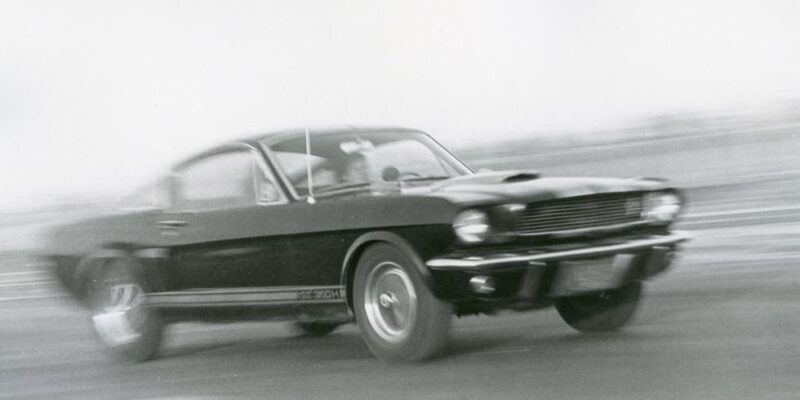The 1966 Ford Shelby Mustang GT350-H tested

Cigarette butts in the ashtray of a rented car? Not when we rented a Shelby Mustang GT 350H from Hertz. No—sir we found cigarette butts in the rear brake scoop. What other rent-a-car outfit can make that claim? One of the technical boys at Shelby once hinted that those distinctive scoops on the flanks of the Cobra-ized Mustang are more decorative than functional, that the rear brakes don’t need any more fresh air, except when racing. Apparently, nobody realized that Shelby’s ingenious crew had created the world’s first external cigarette receptacle.
Seriously, the alliance between Shelby and Hertz has eliminated the necessity of owning a sports car. Now the enthusiast can have his cake and eat it too. Rates vary according to locale: in the New York area it was a moderate $17 per day (or $70 per week) and 17 cents per mile. Hertz wouldn’t rent us one when there was snow on the ground; said they didn’t have snow tires for it. (New York has a law that says you get towed off the roads in a “snow emergency” if you don’t have approved snow tires.)
Renting a Shelby Mustang is bound to be more ego gratifying than a no-go small-bore import or a big, blowsy “sport-type” American sedan. The GT 350 is a real guts sports car, with hair on its chest—all the way down to its navel. Shelby has contracted to supply Hertz with one thousand GT 350s, designated the GT 350H (“H” for Hertz). Most of these special GT 350s will have the new high-performance automatic transmission, although a limited number will be available with 4-speed manual transmissions for the do-or-die purists. Said puristi will have to join the Hertz Sports Car Club, the qualification for membership being a demonstration of your ability to operate a manual gearbox. Hertz then gives you a little card, so the next time you want to rent a stick shift Shelby Mustang, you just flash your smile and your HSSC card.
There isn’t any significant difference between the GT 350 you can buy and the Hertz version. The standard GT 350H color scheme is black with two broad gold stripes—a sensational, crowd-stopping combination. Other color schemes are available, including the regular GT 350’s white with two broad blue stripes. A trio of narrower stripes along the rocker panel are interrupted by a “G.T. 350H” nameplate behind each front wheel. All the Hertz cars have the “occasional” rear seats and “mag-type” wheels that are options on the GT 350. Incidentally, the “H” might well stand for “Homologated” if Shelby—or, for that matter, Hertz—wanted to race the car as a Group 2 sedan; the 1000 examples Shelby will produce for Hertz fulfill the FIA’s minimum production requirement.
Nor is there any significant difference between this year’s Shelby Mustang and last year’s, although there is a whale of a difference between Ford’s stock $3500 Mustang and Shelby’s version. Standard high-performance, 271-horsepower Mustangs are delivered to the Shelby American factory near Los Angeles International Airport, where they are rebuilt to GT 350 specifications. Wide-base wheels and 130-mph 7.75 x 15 Goodyear Blue Streaks are fitted, as are trailing arms at the rear, a one-inch anti-sway bar at the front, and Konis all around.
The front suspension geometry is altered, the steering speeded up, and a chassis brace is installed across the engine compartment between the upper shock mounts. The front brakes are 11-inch Kelsey-Hayes discs with heavy-duty pads; the rear brakes are 10 x 3-inch drums (3/4-inch wider than stock) with sintered metallic linings. Finned, cast aluminum rocker covers and sump are bolted on, as is a high-riser intake manifold and a big 4- barrel carb with 1.7-inch venturis and center-pivot floats so it won’t cut out in turns.
This, along with fabricated steel headers and low-restriction mufflers, boosts the horsepower figure by 35, to 306 @ 6000 (vs. stock 271 @ 6000), and the torque from 312 lbs-ft. @ 3400 to 329 lbs-ft. @ 4200. Final touches include the rear brake scoops, a new hood with a big air scoop and NASCAR-style hood pins, plexiglass rear quarter windows in place of the regular Mustang fastback’s vent panels, a cleaned-up grille with the Mustang emblem offset to the driver’s side, and the stripes. There are about a million options for racing the GT 350 in the SCCA’s B Production category, many of which were proved in competition by the Cobra 289 and Ford’s racing GT 40, both of which also use the basic Fairlane V-8. Last year, in their first season of racing, the GT 350s won several National Championships, including the final play-off at Daytona.
Full story Car and Driver: https://www.caranddriver.com/reviews/a15141429/1966-ford-shelby-mustang-gt350-h-road-test/
